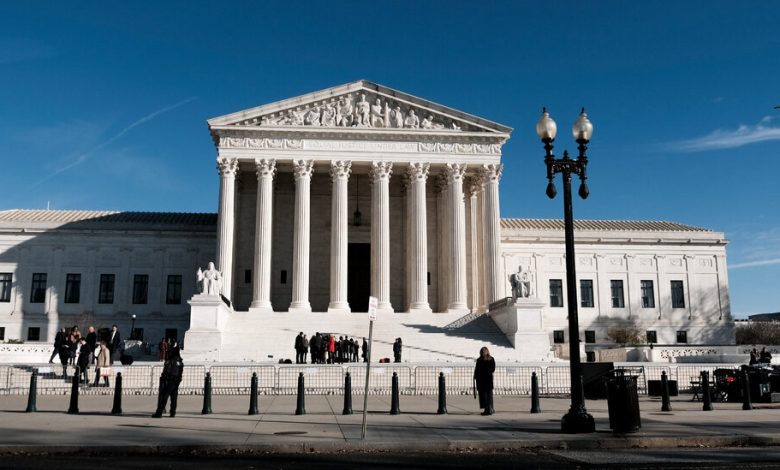Supreme Court Puts Off Considering State Laws Curbing Internet Platforms

WASHINGTON — The Supreme Court asked the Biden administration on Monday for its views on whether the Constitution allows Florida and Texas to prevent large social media companies from removing posts based on the views they express.
The practical effect of the move was to put off a decision on whether to hear two major First Amendment challenges to the states’ laws for at least several months. If the court ends up granting review, as seems likely, it will hear arguments no earlier than October and will probably not issue a decision until next year.
The two state laws, which are similar but not identical, were largely the product of conservative frustration. The laws’ supporters said the measures were needed to combat what they called Silicon Valley censorship. In particular, they objected to the decisions of some platforms to bar President Donald J. Trump after the attack on the Capitol on Jan. 6, 2021.
The laws were challenged by two trade groups, NetChoice and the Computer & Communications Industry Association, which said the First Amendment prohibits the government from telling private companies whether and how to disseminate speech.
The Florida law imposes fines on large social media platforms that refuse to transmit the views of politicians who run afoul of their standards.
In a statement issued when he signed the Florida bill, Gov. Ron DeSantis, a Republican, said the point of the law was to promote conservative viewpoints. “If Big Tech censors enforce rules inconsistently, to discriminate in favor of the dominant Silicon Valley ideology, they will now be held accountable,” he said.
The Texas law differs in its details, Judge Andrew S. Oldham wrote in a decision upholding it. “To generalize just a bit,” he wrote, the Florida law “prohibits all censorship of some speakers,” while the Texas law “prohibits some censorship of all speakers” when based on the views they express.
Understand the U.S. Supreme Court’s New Term
A race to the right. After a series of judicial bombshells in June that included eliminating the right to abortion, a Supreme Court dominated by conservatives returns to the bench — and there are few signs that the court’s rightward shift is slowing. Here’s a closer look at the new term:
Affirmative action. The marquee cases of the new term are challenges to the race-conscious admissions programs at Harvard and the University of North Carolina. While the court has repeatedly upheld affirmative-action programs, a six-justice conservative supermajority may put more than 40 years of precedents at risk.
Voting rights. The role race may play in government decision-making also figures in a case that is a challenge under the Voting Rights Act to an Alabama electoral map that a lower court had said diluted the power of Black voters. The case is a major new test of the Voting Rights Act in a court that has gradually limited the law’s reach in other contexts.
Online speech. In a few upcoming cases, the Supreme Court is poised to reconsider two key tenets under which social networks have long operated: that the platforms have the power to decide what content to keep online and what to take down, and that the websites cannot be held legally responsible for most of what their users post online.
Discrimination against gay couples. The justices heard an appeal from a web designer who objects to providing services for same-sex marriages in a case that pits claims of religious freedom against laws banning discrimination based on sexual orientation. The court last considered the issue in 2018 in a similar dispute, but failed to yield a definitive ruling.
Immigration. The Supreme Court will hear arguments on the constitutionality of a 1986 law that makes it a crime to urge unauthorized immigrants to stay in the United States. The justices had already heard arguments on that question three years ago; several of them suggested then that the law violated the First Amendment.
The Texas law applies to social media platforms with more than 50 million active monthly users, including Facebook, Twitter and YouTube. It does not appear to reach smaller platforms that appeal to conservatives, like Truth Social and Gettr, the law’s challengers told the Supreme Court.
The law also does not cover sites that are devoted to news, sports, entertainment and other information that their users do not primarily generate. The covered sites are largely prohibited from removing posts based on the viewpoints they espouse, with exceptions for the sexual exploitation of children, incitement of criminal activity and some threats of violence.
Federal appeals courts reached conflicting conclusions about the constitutionality of the two laws.
In May, a unanimous three-judge panel of the U.S. Court of Appeals for the 11th Circuit largely upheld a preliminary injunction blocking Florida’s law.
“Social media platforms exercise editorial judgment that is inherently expressive,” Judge Kevin C. Newsom wrote for the panel. “When platforms choose to remove users or posts, deprioritize content in viewers’ feeds or search results, or sanction breaches of their community standards, they engage in First Amendment-protected activity.”
In September, however, a divided three-judge panel of the Fifth Circuit reversed a lower court’s order blocking the Texas law.
“We reject the platforms’ attempt to extract a freewheeling censorship right from the Constitution’s free speech guarantee,” Judge Oldham wrote for the majority. “The platforms are not newspapers. Their censorship is not speech.”
The Supreme Court has already had an encounter with the Texas law, temporarily blocking it in May while an appeal moved forward. The vote was 5 to 4, with an unusual coalition in dissent.
More on the U.S. Supreme Court
- Leaked Draft Opinion: The Supreme Court announced that an internal inquiry failed to identify who leaked a draft of the opinion that overturned Roe. The investigation included interviews with all nine justices.
- Inside the Inquiry: The court’s leak investigation was meant to right the institution amid a slide in public confidence. Instead, employees say, it deepened suspicions and caused disillusionment.
- New York’s Gun Law: The justices rejected a request from firearms dealers to block parts of recent state laws, days after it turned down a request to block other provisions of one of the laws at issue.
- Donors Meet the Justices: A charity was created to preserve the court’s history. It also became a door to nine of America’s most powerful people.
The court’s three most conservative members — Justices Samuel A. Alito Jr., Clarence Thomas and Neil M. Gorsuch — filed a dissenting opinion saying that they would have left the law in place and that the issues were so novel and significant that the Supreme Court would have to consider them at some point.
“Social media platforms have transformed the way people communicate with each other and obtain news,” Justice Alito wrote in the dissent. “At issue is a groundbreaking Texas law that addresses the power of dominant social media corporations to shape public discussion of the important issues of the day.”
Justice Alito added that he was skeptical of the argument that the social media companies have editorial discretion protected by the First Amendment like that enjoyed by newspapers and other traditional publishers.
“It is not at all obvious,” he wrote, “how our existing precedents, which predate the age of the internet, should apply to large social media companies.”
Justice Elena Kagan, a liberal, also said she would have let a judge’s injunction against the law stand, though she did not join the dissent and gave no reasons of her own.
The Supreme Court will hear arguments next month in a different case examining what in some ways is the flip side of the question in the ones from Florida and Texas: whether social media platforms may be sued despite a law that shields the companies from legal responsibility for what users post on their sites. The case, brought by the family of a woman killed in a terrorist attack, argues that YouTube’s algorithm recommended videos inciting violence.
That case, Gonzalez v. Google, No. 21-1333, concerns Section 230 of the Communications Decency Act, a 1996 law that helped enable the rise of social networks like Facebook and Twitter.
The court’s request for the administration’s views in the two new cases — Moody v. NetChoice, No. 22-277, and NetChoice v. Paxton, No. 22-555 — probably means that it will rule on the case concerning the 1996 law before it decides whether to hear the new cases.




